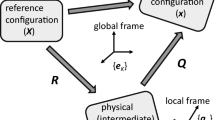Abstract
Maximization of the rate of dissipation is applied to develop a viscoelastoplastic damaging material model with anisotropic properties and finite deformation. The thermodynamic framework suggests a new damage activation criterion based on the sum of stress and an energy release rate based on a damage-based strain measure. The framework combines the usually disjointed ideas of effective stress and damage strain kinematics to track the dimensional changes attributed to damage while retaining the physical link to load-bearing area reduction. Potential applications include large volume change oxidation of SiC CMC composites, high temperature creep and relaxation influences on damage processes in reinforced polymers and ceramics, and opening/closing of cracks via natural elastic behavior as opposed to treatments based on loading criteria.
Maximum rate of dissipation analysis is applied to develop a framework corresponding to a material model incorporating three strain elements characterized by viscoelastic, damage, and viscoplastic behaviors. A push-pull framework associates these behaviors with respective multiplicative deformation gradients with rates determined by Lie material derivatives.
Access provided by Autonomous University of Puebla. Download conference paper PDF
Similar content being viewed by others
Keywords
Kinematic/Kinetic Definitions
The present study considers materials which may undergo viscoelastoplastic damage under finite strains. The configurations and associated deformation gradients are depicted in Fig. 1, where F c is viscoplastic/creep, F d is damage, and F veis viscoelastic, with F = F eF dF c the multiplicative decomposition of the total deformation. τ is the Kirchhoff stress.
Denoting also F dc = F dF cfor convenience and with F e = F ve and E e = E ve (Voigt assumption), strain measures are given by, strain measures are given by
It can be noted that while \( {\tilde{\mathbf{E}}}^e={\tilde{\mathbf{E}}}^e\left[{\mathbf{F}}^e\right] \) and \( {\tilde{\mathbf{e}}}^d={\tilde{\mathbf{e}}}^d\left[{\mathbf{F}}^d\right] \), \( {\tilde{\mathbf{e}}}^c \) has the mixed dependency \( {\tilde{\mathbf{e}}}^c\left[{\mathbf{F}}^c,{\mathbf{F}}^d\right] \), but \( {\tilde{\mathbf{e}}}^c=0 \) when F c = 0 and \( {\tilde{\mathbf{e}}}^c \) pushes/pulls properly with the deformation.
The Lie derivatives employed for tensors associated with \( \tilde{\kappa} \) are material derivatives of these tensors when pulled back to the reference configuration κ R, then pushed back to \( \tilde{\kappa} \), as illustrated by that of \( \tilde{\mathbf{E}} \):
Stress measures and stress power combinations are given by:
with
A similar kinematic/kinetic framework with one intermediate configuration is detailed by Stumpf [1].
Thermodynamics/Constitutive Development
The reduced energy dissipation equation, assuming a split of the entropy production into mechanical and thermal components, is given by (ψ, ρ o, η, θ, q 0 are respectively Helmholtz energy, reference density, specific entropy, temperature, and heat flux referred to the reference configuration):
Assuming \( \psi =\tilde{\psi}\left[{\tilde{\mathbf{E}}}^{ve},{\tilde{\mathbf{e}}}^d,{\tilde{\mathbf{e}}}^c\right] \) with the chain rule for \( \overset{\triangle }{\psi } \) it follows:
Based on the dissipation relation, the following are adopted as inelastic activation criteria:
The second activation criterion is noteworthy. \( {\tilde{\mathbf{e}}}^d \) is a strain-based measure of damage; \( \tilde{\mathbf{Y}} \) is thus called here the damage strain energy release rate, and appropriately reflects the loss of stored energy occurring with damage. The combination of \( \tilde{\mathbf{Y}} \)with the stress \( \tilde{\mathbf{S}} \) is thus thermodynamically implied to drive damage in accordance with the dissipation eq.
A Lagrange function is defined for application of assumed maximization of the rate of dissipation (cf. [2, 3]), where \( s=\left\{{\tilde{\mathbf{E}}}^{ve},{\tilde{\mathbf{e}}}^d,{\tilde{\mathbf{e}}}^c\right\} \)is the state and λ is a Lagrange multiplier constraining the assumed dissipation function \( {\tilde{\xi}}^{mech}\left[\overset{\triangle \kern0.75em }{{\tilde{\mathbf{E}}}^{ve}},\overset{\triangle \kern0.5em }{{\tilde{\mathbf{e}}}^d},\overset{\triangle \kern1.75em }{{\tilde{\mathbf{e}}}^c;s}\right]={\tilde{\xi}}^{ve}\left[\overset{\triangle \kern0.5em }{{\tilde{\mathbf{E}}}^{ve}};s\right]+{\tilde{\xi}}^d\left[\overset{\triangle \kern0.5em }{{\tilde{\mathbf{e}}}^d};s\right]+{\tilde{\xi}}^c\left[\overset{\triangle \kern1.75em }{{\tilde{\mathbf{e}}}^c;s}\right] \) to obey the derived dissipation equation:
Maximization of Φ leads to
Assuming simple quadratic dissipation relations for each of \( {\tilde{\xi}}^{ve},{\tilde{\xi}}^d,{\tilde{\xi}}^c \) leads to the following integrable relations:
Conclusion
The described model corresponds to a Voigt viscoelastic element in combination with damage and viscoplastic elements. The stress employed in the above relations is obtained via an effective stress continuum damage argument, e.g [4]. A fourth-order damage measure connected to the damage strain \( {\tilde{\mathbf{e}}}^d \) permits memory of the accrued damage state while \( {\tilde{\mathbf{e}}}^d \)fluctuates with deformation. Work continues on further defining the detailed constitutive relations and computational implementations.
References
H. Stumpf, Theoretical and computational aspects in the shake down analysis of finite elastoplasticity. Int. J. Plast. 9, 583–602 (1993)
K.R. Rajagopal, A.R. Srinivasa, Mechanics of the inelastic behavior of materials: part II—inelastic response. Int. J. Plast. 14, 969–995 (1998)
K.R. Rajagopal, A.S. Srinivasa, On thermomechanical restrictions of continua. Proc. R. Soc. Lond. A 460, 631–651 (2004)
S. Murakami, Continuum Damage Mechanics (Springer, New York, ISBN 978-94-007-2665-9, 2012)
Author information
Authors and Affiliations
Corresponding author
Editor information
Editors and Affiliations
Rights and permissions
Copyright information
© 2020 Society for Experimental Mechanics, Inc.
About this paper
Cite this paper
Hall, R.B. (2020). Viscoelastoplastic Damage with Maximum Rate of Dissipation-Based Growth Criterion and Tri-Component Lie Rate Decomposition. In: Silberstein, M., Amirkhizi, A., Shuman, X., Beese, A., Berke, R., Pataky, G. (eds) Challenges in Mechanics of Time Dependent Materials, Fracture, Fatigue, Failure and Damage Evolution, Volume 2. Conference Proceedings of the Society for Experimental Mechanics Series. Springer, Cham. https://doi.org/10.1007/978-3-030-29986-6_20
Download citation
DOI: https://doi.org/10.1007/978-3-030-29986-6_20
Published:
Publisher Name: Springer, Cham
Print ISBN: 978-3-030-29985-9
Online ISBN: 978-3-030-29986-6
eBook Packages: EngineeringEngineering (R0)





